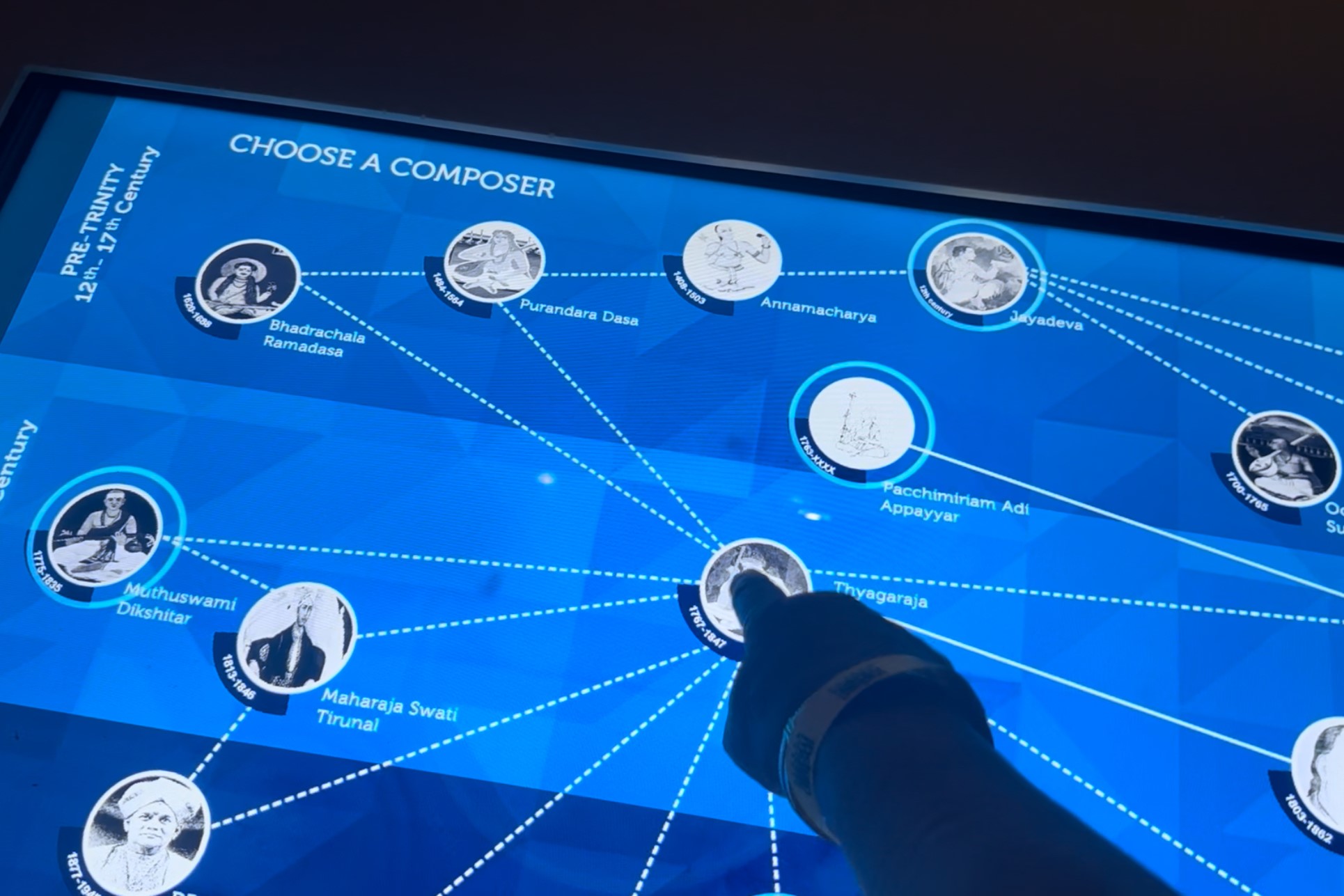A museum of Indian music experience is a journey from old to new sounds
IME takes the audience by the hand through a musical journey of Indian music from the songs of the birds and the humming of humans to Hindustani, Karnatik, fusion, Bollywood and the sounds of modern India on the move.
 Interactive exhibit at Indian Music Experience Museum / Ritu Marwah
Interactive exhibit at Indian Music Experience Museum / Ritu Marwah
Can you imagine a world without music? asks the exhibit on fusion music at The Indian Music Experience Museum (IME), India’s first interactive music museum located in JP Nagar, Bengaluru.
An institutional affiliate of the GRAMMY Museum in Los Angeles, the IME’s vision is “to introduce the youth to the diversity of Indian music and to preserve India’s rich musical heritage,” said Preema John, museum director.
IME’s online activities include regular events and online exhibits on the Google Arts and Culture platform. It has regular online classes in various genres of music as well.
In Bengaluru, the IME, housed in a beautiful building and a sound garden, has exhibits inside and outside the building. A tower invites you to tuck your head in it and hum. The height of the enclosure changes the humming. Inside the museum comprises hi-tech multimedia exhibit galleries, a learning center for music education, and several performance spaces.
A Qawwali music performance by Delhi-based Sufi performer group Mehfil-e-Sama’a was packed. Audience members tucked their jeans-clad legs in and squatted on the floor. Raining requests of Nusrat Fateh Ali’s songs, they clapped, swayed and nodded their heads to the music while the ever-accommodating lead singer sang out a few lines for almost every song requested. A couple said they heard of the museum from their children who came here with their school.
The museum prods its visitors, “Where temples have no chants, lovers have no melodies, babies have no lullabies? In a country where no celebration is complete without music, it gives us life. We all have music that we listen to, and say, 'Ah, that's my song. But just as we are different and yet connected to each other, our music, though diverse, shares common roots, and continues to evolve.”
IME takes the audience by the hand through a musical journey of Indian music from the songs of the birds and the humming of humans to Hindustani, Karnatik, fusion, Bollywood and the sounds of modern India on the move.
“Indian classical music is ancient in origin yet constantly evolving. Its earliest sources include the ritual incantations of Vedic scriptures over 2,000 years ago and the timeless wellspring of folk music of the subcontinent. Alongside the two main traditions of Karnatik and Hindustani classical music, are numerous streams of devotional music, which have both received from and given back to the classical traditions. Classical music is guided by well-defined structures and frameworks and yet brims with scope for creative articulation. It stimulates the mind, soothes the soul, and continues to be the benevolent mother to a variety of musical expressions,” the museum tells its audience.
Homegrown musicians fearlessly combine Indian and Western influences to create hybrid sounds
For over half a century, traditional Indian classical musicians have crossed barriers between cultures and musical genres to collaborate on the global stage. “Now,” says IME, “a new generation of homegrown musicians are fearlessly combining Indian and Western influences to create hybrid sounds that are fiercely independent and quintessentially Indian, but with global appeal. They defy labels and expectations, and attempt to give authentic expression to the way we are now.”
Contemporary Indian music, which includes rock, pop, fusion and everything in between, is no longer a niche category but an increasingly popular genre of music with a rapidly expanding audience,” says the museum.
“'Fusion', world music', 'urban folk', 'crossover'—these a are some of the many terms used to describe contemporary music. But what gives this sweeping range of sound a musical identity?” the visitors are asked. “Is it the way that Indian and Western instruments share the stage? Or how guitars and drums converse with ragas and talas? Or does it lie in the possibility of a rock song with Hindi or Bengali lyrics?”
Young people scramble onto autorickshaws rigged up to be movie theaters. They listen to stories by contemporary Indian musicians who argue that their music cannot just be described as a sum of various influences. “When genres, instruments and languages meld seamlessly, the result is not a mix, but music that is altogether different. Like hybrids in nature, these results can be beautiful, unexpected and entirely new.”
Bollywood defines Indie music
IME tells us that in the West, independent or indie music is defined by its independence from mainstream record labels. “In India, where film music commands the most listenership, the term refers to music created outside the film industry. While early indie groups played covers of Western bands, today they play original music, drawing on a wide range of influences, from rock to Indian classical music, from folk to electronic-based sound.
The identity of indie music lies in the fact that it is not mass produced, but the result of genuine creative expression. With growing audiences and an expanding range of sounds, the history of indie music is still very much in the making.”
The music of new India blends the nimbu paani of the old world to make a new lemonade.




.jpg)
.jpg)

.jpg)

.jpg)
.jpg)





Comments
Start the conversation
Become a member of New India Abroad to start commenting.
Sign Up Now
Already have an account? Login